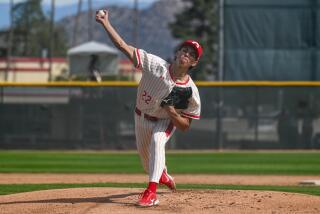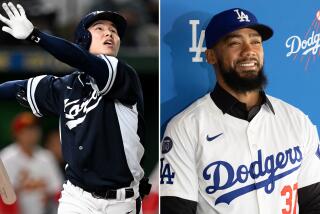Cuban Phenom Is Out of Shape, but Marlins Like His Chances
- Share via
MELBOURNE, Fla. — Look, the kid made $5 a month as a member of the Cuban national team. Now he’s getting $505 a week in spring training meal money and doesn’t even have to dip into that record $2.5-million signing bonus that was part of the four-year, $4.5-million deal with the Florida Marlins.
If the kid wants to style a little, if he wants to show up with agent Joe Cubas in a white stretch limousine for his exhibition debut, as he did Wednesday, what’s the harm?
He also showed up with his head shaved and looking a little overweight, to put it kindly. The image was that of a product made by Brunswick, but the results were more impressive.
True, 21-year-old Livan Hernandez was pitching against the University of Miami, but his two-inning, one-hit performance seemed to wow a stadium full of scouts, and Hernandez, registering in the low 90s on the speed guns, said he will get better and faster as he gets stronger.
“He has tremendous potential, definitely a high ceiling,” Kansas City Royal scouting director Art Stewart said. “Any club in baseball would love to have him. I know we would, but the bidding got out of our range.”
That was during a winter feeding frenzy when another Cuban pitcher, Osvaldo Fernandez, was signed by the San Francisco Giants for a surprising $3.6 million over three years, even though he is eight years older than Hernandez, doesn’t have comparable stuff and the Bay Area’s Cuban community isn’t quite the size of South Florida’s.
The Marlins think Hernandez has a chance to join John Burkett, Pat Rapp, Al Leiter and Kevin Brown in their rotation, although the realistic outlook is that he is more likely to open in triple A despite his Miami marketing value.
The Oakland Athletics gave Cuban Ariel Prieto, 26, a $1.2-million bonus as their first-round draft choice last June, allowed him to start out in the majors, and he went 2-6 with a 4.97 earned-run average. There has been some grumbling among Marlin veterans about the prospect of Hernandez stepping in at the big league level, the feeling being that he is not ready physically or mentally to cope with the daily grind.
He reported at least 10 pounds over his listed weight of 220, failed to complete the last two of a dozen 220-yard runs assigned to pitchers during the opening week, and was unable to finish his assigned session on the exercise bike. Hernandez resembles the formidable Sid Fernandez from the back and may continue to need pants with a 40-inch waist even after he loses some weight.
“He’s got to get in shape . . . but to me, a guy can be 250 if he gets guys out,” Manager Rene Lachemann said. “It’s not a Mr. Universe contest. I just care about results.”
Lachemann liked the results Wednesday.
“If he wasn’t nervous, he’s not a human being,” Lachemann said. “The bottom line is that he got them out. I don’t care if he’s nervous as long as he isn’t making me nervous.”
Said Hernandez, before calling for the limo: “I never got anything for free. I always have worked hard and battled to win a job. That’s what I have in mind now--to fight and see if I can make this club.”
*
The Marlins finished 22 1/2 games behind the Atlanta Braves in the National League East last year but were 43-34 in the second half. Given that momentum and a sense that South Florida interest was waning after three years, the club decided to accelerate the building process by committing $35.9 million to four free agents: center fielder Devon White ($9.9 million for three years) and pitchers Brown ($12.9 million for three), Leiter ($8.6 million for three) and Hernandez. “Our basic philosophy hasn’t changed,” club President Dave Dombrowski said. “It’s still based on scouting and development, but where it changed is that we had a choice of staying strictly with that program, knowing we probably wouldn’t have a competitive club for another three or four years, or adding to the process and becoming competitive more quickly.
“I don’t think we could have sustained the honeymoon in South Florida for another three or four years. We drew more than 3 million [an average of 37,838] our first year [1993], but the projection over a full season last year [when strike reaction played a part in the 24,282 average] was 2.5 or so. We couldn’t keep going down like that. Fortunately, we had an improving nucleus and didn’t need a lot of expensive pieces.”
The success of the Colorado Rockies, who reached the playoffs in their third season, also led toward owner Wayne Huizenga’s spending spree. No one can question the signing of White--the Marlins’ strength up the middle now includes Gold Glove winners in center field and behind the plate (Charles Johnson) and a young and talented double-play duo of Kurt Abbott and Quilvio Veras--but the Brown and Leiter contracts created consternation in the industry.
Brown won 21 games with Texas in 1992 but has gone 15-12, 7-9 and 10-9 since. Leiter won a career-high 11 games with a bad Toronto team last year (he also lost 11), but was a modest 9-6 and 6-7 with a very good Toronto team in the two previous years.
Nevertheless, with veteran leadership in Terry Pendleton and Andre Dawson, with a sound Gary Sheffield returning to supplement Jeff Conine’s power, with the 1995 advancement of pitchers Pat Rapp and Robb Nen, with the solid base up the middle, the Marlins are happy fish, feeding on the additions of last winter.
“Everyone in the organization is excited, no question about it,” Lachemann said. “This is the first year we’ve gone through spring training knowing we have a chance to compete on a daily basis.
“You’re not giving them Knute Rockne pep talks now, by any means. They realize what’s ahead of them and that we have a chance to be much improved. At the same time, all the talk doesn’t mean anything. We have to do it. I mean, we’ve yet to play .500 ball for a season. We have to climb one mountain at a time.”
More to Read
Go beyond the scoreboard
Get the latest on L.A.'s teams in the daily Sports Report newsletter.
You may occasionally receive promotional content from the Los Angeles Times.










